A Grim Milestone: Inside Israel on October 7 Anniversary
As we wound our way south from Jerusalem to Sderot, a small western Negev city that borders the northeast corner of the Gaza Strip, we received instruction on what to do in the event of a missile strike.
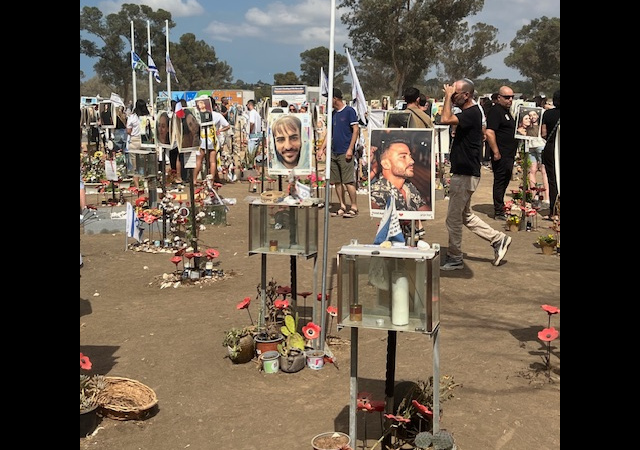
The Israeli Defense Forces reported on Monday that in the one year since Hamas terrorists launched their unprovoked and brutal attack on Israeli civilians, the country has been the target of more than 26,000 missiles, rockets, and drones. To date, 13,200 projectiles have been fired from Gaza into the beleaguered nation, 12,400 from Lebanon, 400 from Iran, 180 from Yemen, and roughly 60 from Syria.
We are currently traveling through Israel with a group led by CBN war correspondent Chuck Holton, whose courageous and reliable daily livestreams from Israel in the days and months following the attacks were watched by hundreds of thousands of people in the U.S. and beyond. The purpose of our trip was to stand with Israel on the anniversary of the nation’s most harrowing day since the Holocaust.
As we wound our way south from Jerusalem to Sderot, a small western Negev city that borders the northeast corner of the Gaza Strip, we received instructions on what to do in the event of a missile strike. Our best option, of course, was to run to the nearest bomb shelter. If that wasn’t possible, we were told to lie face down on the ground.
The warning wasn’t crazy. After all, a missile launched from Gaza on Sunday had wounded two civilians. Additionally, during the roughly 90-minute drive, Tzofar, a cell phone app that provides “red alerts” on sirens throughout Israel, signaled that rocket or missile strikes had been detected east of the Gaza Strip near the Egyptian border. Israel’s Iron Dome had intercepted all of those strikes.
There was also the danger that Palestinian snipers inside Gaza might target individuals randomly.
(Every member of our group – about 40 strong – had been called upon by families and friends before leaving to cancel our plans as if setting foot in Israel meant certain death.)
We stopped at an overlook in Sderot. Beyond the border wall that separates Gaza from the rest of Israel, we saw only rubble. At one point, a muzzle flashed in the distance, followed by a loud explosion. A moment later, heavy grey smoke could be seen billowing up from the target.
Prior to Oct. 7, 2023, the population of Sderot had been more than 30,000. Many people fled the city following the attacks, reducing the number of residents to 5,000. But most of them have since returned to their homes. According to Chuck, the number of missile strikes into Sderot has fallen back to pre-Oct. 7 levels. This is to say that missiles were targeting the city long before Hamas’s barbaric assault.
Bomb shelters are prevalent throughout the city, particularly in playground areas. One shelter resembled a brightly colored caterpillar. Since the attacks, the city has upgraded them, making them lockable from inside.
Shortly after leaving Sderot, we learned that a Hamas missile had just targeted the overlook we had just come from. Fortunately, that missile was intercepted as well.
Next, we visited the site of the Nova Music Festival, where 364 people were murdered. In a wide-open field, small trees had been planted, one for each soul who had perished in the massacre. In a shady park adjacent to the field, people had gathered in small groups around makeshift memorials for their loved ones. The anguish they felt was palpable.
In some ways, it felt like visiting a concentration camp. The knowledge that something evil had occurred there was unmistakable.
Yet, unlike a concentration camp, the grief was still so new and so raw. And rather than reflecting on atrocities that occurred long before most of us were born, this story is happening now and has yet to play out. We are still in the middle of it.
During our time there, sporadic – but loud – explosions pierced the quiet, somber, and deeply emotional feeling of the occasion. The IDF was striking targets inside the Gaza Strip, several miles west of the site.
Approximately ten kilometers away from the Nova site, we passed the “car graveyard” or the “burnt cars compound,” where the remains of more than 1800 cars damaged during the horrific attacks are located. “You will find dozens of burnt cars hit by Hamas, and many damaged and recognizable cars belong to police and IDF forces and to people who saved others from the Nova festival by driving back and forth. Many Hamas cars with machine guns and motorcycles are also displayed on the compound.”
A surveillance balloon, known in the military as a “Gorgon stare,” flew over the site of a kibbutz where over 10% of those who lost their lives on that day were killed. Chuck said when he arrived two days later, the open field in front of the kibbutz was covered with body bags.
Reminders that the country remains at war were all around us. Just as the residents of Sderot returned to their homes now that the number of missile strikes has returned to pre-war levels, the people have learned to live with these conditions. The most amazing observation of all is that life goes on as usual for most Israelis.
Elizabeth writes commentary for The Washington Examiner. She is an academy fellow at The Heritage Foundation and a member of the Editorial Board at The Sixteenth Council, a London think tank. Please follow Elizabeth on X or LinkedIn.
 DONATE
DONATE
Donations tax deductible
to the full extent allowed by law.

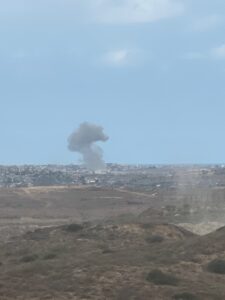
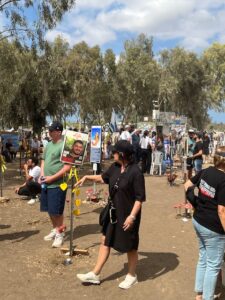
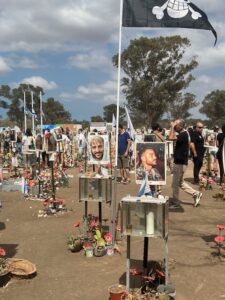
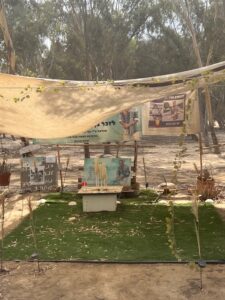
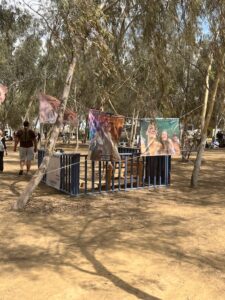
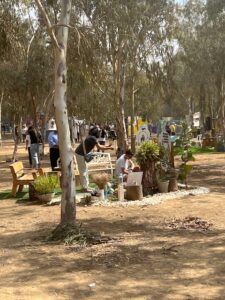
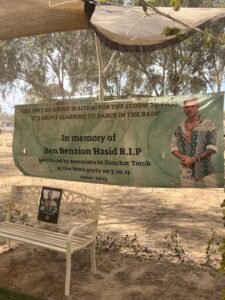
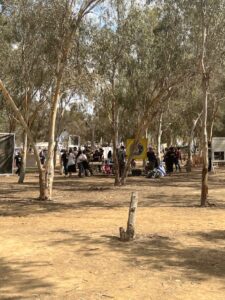
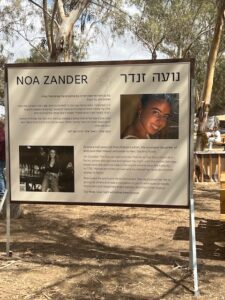








Comments
What a painful place, I hope one day the memorial is beautiful beyond words, yet so solemn
Never again….
And our “beloved” woke NFL
What is the sting, better to shit your mouth than to erase all doubt?
MN Somalia is us
https://www.breitbart.com/sports/2024/10/07/vikings-october-7-statement-blasts-antisemitism-and-islamophobia/
not sure if you would feel safe/comfortable asking of the guides but
how come//what is thought by the israeli citizens on not having the right to own weapons and do they feel that if the citizens were armed many of these tlaib led attacks would not be successful to any degree
stay safe!
At one time, civilians did carry rifles – I remember the photos. The assumption was that everyone, male and female, had been through army training and knew how to use them. i was shocked that people living so close to Gaza in 2023 were not armed. Furthermore, it seems that their residential bomb shelters were designed to let in emergencvy personnel after a rocket attack, and so were not able to keep terrorists out. Just incredible from my viewpoimt. As an American, I would not live that close to people openly hoping for my destruction without being armed and having plans on how to survive an assault.
They have weapons, but they are all locked up in one local place
Ridiculous
No. Any photos you remember seeing were of soldiers, not civilians. Israel has no tradition of an RKBA. (Or of a freedom of speech, for that matter. But certainly not of an RKBA.) The typical Israeli’s attitude is much like that of the typical European or Japanese, with a strong presumption against civilians being armed, and applicants having to prove a need for an exception to be made for them. Like in “may issue” states before McDonald.
And yet I specifically remember a photo of a young, female teacher at the back of a line of youngsters filing down steps towards the entrance to a museum or something similar. And the teacher had a rifle slung over her shoulder. It was a long time ago, perhaps during a war, but I assumed the photo was of daily life in Israel. Are you sure that wasn’t true in ’73 or even ’67? I certainly realize it’s not true now.
Ever since Palestinians massacred school children in Maalot. In 1974, https://en.m.wikipedia.org/wiki/Ma'alot_massacre school trips must be accompanied by armed guards. But the guards need a license to have the firearm.
I have wondered if that law is because of the large percentage of Muslims?
No, it has nothing to do with that. It’s left over from British days, and it has never occurred to most people that it should be changed.
The current Homeland Security minister, Itamar Ben-Gvir, is an exception and has long championed loosening the gun laws. But the typical Israeli voter doesn’t agree.
Good question. Will ask at next stop.
Hi DC: The guide said that slightly more than 60% of Israelis are armed. Women who serve for two years and men who serve more than three years are allowed to have long guns and many over the age of 27 are allowed to have pistols. If they carry their weapon, they must wear a hat that is labeled “armed citizen.” I was surprised at the >60% figure.
One more thing: our guide served in the military for 1 1/2 years. He was injured and left service. So, he had to wait until age 27 to obtain a gun.
Read it and weep
Now they are bringing in a “counselor “ for the staff
Must be rough to be black, a victim, and pro Palestinian
https://hotair.com/john-s-2/2024/10/07/on-107-cbs-news-apologizes-for-questioning-ta-nehisi-coates-about-his-book-n3795521
Just read it. Pathetic!
Biden to Netanyahu after killing of Fuad Shukr: ‘Bibi, what the f-?’
President Dementia Joe was furious after the elimination of a Hezbollah leader who had a $5 million bounty on his head from the US for his role in killing hundreds of American servicemen.